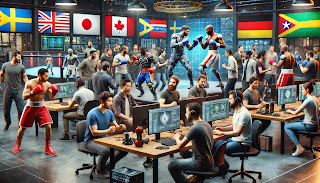The Difference Between Boxing and Fighting Games: Why Boxing Fans Reject the Blur
In the world of gaming, combat-based titles have long been divided into distinct categories. Among them, boxing games and fighting games stand apart—each offering a unique experience based on the nature of the sport or combat style they aim to replicate. However, in recent years, some companies have attempted to blur the lines between these genres, creating hybrid experiences that, while appealing to a broad audience, fail to satisfy dedicated boxing fans.
Boxing Games vs. Fighting Games: The Fundamental Differences
At their core, boxing games are designed to simulate the sport of boxing. This means adhering to real-world rules, strategies, and techniques. The focus is on fundamentals such as footwork, ring control, punch accuracy, defense, stamina management, and tactics that align with the sweet science. Successful boxing games aim to replicate the chess match that takes place inside the ring, making realism a priority.
On the other hand, fighting games—such as Street Fighter, Tekken, or even UFC titles—are structured differently. They emphasize exaggerated movement, quick reaction-based inputs, and often involve mechanics that have little to do with real-world fighting physics. These games thrive on accessibility and action-packed sequences, prioritizing entertainment over simulation. Even games that lean into "realistic" combat, such as the UFC series, often include elements like button-mashing combos, parries that work universally, and stamina meters that function more like cooldowns rather than a reflection of real-life fatigue.
Companies Trying to Blur the Lines
In an attempt to appeal to a broader audience, some game developers have taken a misguided approach, implementing fighting game mechanics into boxing games. They assume that fans of one genre will seamlessly accept elements from the other. Features such as unrealistic punch speeds, excessive combo systems, super move meters, or arcade-like counters are creeping into titles that claim to be boxing simulations.
For instance, Undisputed, a game that initially marketed itself as a hardcore boxing sim, has introduced mechanics that feel more like a fighting game experience. Features like excessive counters, unrealistic stamina recovery, and exaggerated foot movement that allows for arcade-style dashes contradict the very essence of boxing realism. This shift has left many diehard boxing fans feeling alienated.
Why Boxing Fans Aren’t Accepting It
Boxing fans have been starved for a proper simulation experience for over a decade. Games like Fight Night Champion scratched the surface but still had arcade elements that frustrated realism purists. With modern technology advancing to the point where true-to-life boxing mechanics can be faithfully recreated, there is no reason to dilute the experience by incorporating mechanics that do not belong in the sport.
Many boxing fans argue that developers should focus on:
- Accurate Boxer Styles & Tendencies – Real-life boxers have unique movement patterns, defensive styles, and punch deliveries that should be captured authentically.
- Proper Stamina & Damage Systems – Boxing is about endurance and attrition, not executing endless combinations without consequence.
- Realistic Defensive Options – A solid defense should not be reduced to just timed counters. Blocking, head movement, clinching, and positioning should all play significant roles.
- Strategic Fighting – Success in boxing comes from intelligence and adaptability, not simply executing the most stylish moves.
When companies blur the lines, they risk alienating the very audience that has been longing for an authentic experience. Boxing fans aren’t just rejecting these hybrid mechanics out of stubbornness—they’re rejecting them because they fundamentally go against what makes boxing a unique and strategic sport.
The Path Forward
For a true boxing game to succeed, developers must stop treating boxing as just another fighting game subgenre. Instead of attempting to "gamify" the sport with unnecessary additions, they should fully embrace realism. From nuanced movement and tactical engagements to real-world boxing physics and AI behavior, the focus should be on creating a boxing simulation that respects the sport and its fans.
The bottom line is clear: boxing is not just another fighting game. Companies that fail to understand this will continue to face resistance from the boxing community, while those who embrace authenticity have the opportunity to create the definitive boxing simulation experience.







